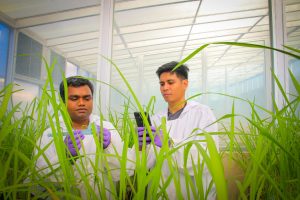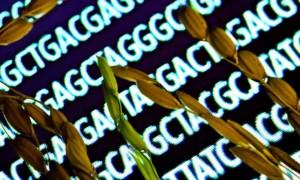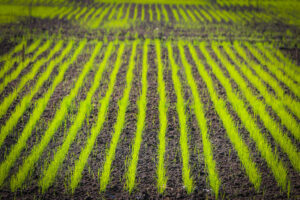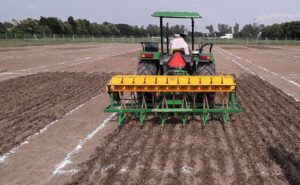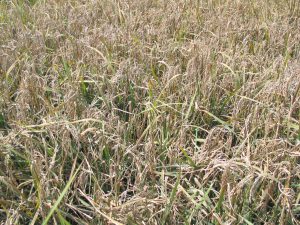Pests should be critically reassessed and proven guilty before insecticide use is contemplated. This was my conclusion in 1994 with the late Professor Michael Way in an extensive review of the role of biodiversity in rice pest management. This landmark publication paved the way to sustainable pest management by enhancing biodiversity and ecosystem services.
Hundreds of arthropod species in rice ecosystems have various ecological functions such as herbivory (feeding on rice plants), predation, parasitization, pollination, decomposition, and nutrient cycling. Herbivores are often labeled as “pests” because they feed on rice plants. Out of more than 100 species, less than 10 species can cause yield loss (if they occur in sufficiently large numbers). Predators and parasitoids that attack them, however, keep them from increasing in number. This intricate food web of relationships among rice plants, pests, and the rich biodiversity of natural enemy species constantly strives toward equilibrium to prevent abnormal developments in pest species.
Engineering the ecology
Ecological engineering is an approach to restore or enhance biodiversity of both floral and faunal species, in the rice landscape, so that resources in the form of shelter and food for the natural enemies are enhanced. It is “the design of human society with its natural environment for the benefit of both.”
Saving the habitats
In most rice landscapes, bunds and nonrice habitats occupy a substantial proportion. Some are populated with fruit trees and shrubs, or grown with vegetables. But, farmers often treat these areas as wastelands and spray them with herbicides, mistakenly thinking that they harbor pests.
Most of the key pests of rice are monophagous (restricted to rice). They just move from rice patch to rice patch. These nonrice habitats provide refuge, food, and homes for natural enemies of rice pests.
In the Philippines and Thailand, rice bunds with the perennial Brachiaria grasses are home to two species of crickets that are ferocious predators of pest eggs laid on leaves. These foragers are nocturnal. They move into rice fields in search of food at night and return to their grassy homes come daytime. Many spider species also depend on these grassy habitats.
Flowers vs. pests
Aside from conserving natural habitats, ecological engineering can augment biodiversity by planting nectar-rich flowers on bunds. These flowers provide nectar for bees and other species that pollinate fruit crops in rice landscapes. The nectar is also food to many hymenopteran parasitoids, especially those that regulate rice pest species, such as planthoppers, leafhoppers, stem borers, and leaf folders.
In Vietnam, ecological engineering fields, which have bunds enriched with nectar-rich flowers, had significantly higher parasitism and predation of planthopper eggs that are deeply embedded into the rice tissues. Without using insecticides, farmers from these villages are harvesting similar or higher yields but with a substantial increase in profits from less insecticide use. Something similar was observed in hybrid rice fields in Jin Hua, China.
No to insecticides
Use insecticide only when absolutely necessary and as a last resort. This is an all-important tenet of ecological engineering. Insecticides are, by design, biocides. Organisms that are more likely to be killed in an insecticide-sprayed field are those that have a small size, soft body, and high mobility. Ironically, pest species tend to be larger and less mobile and are thus less vulnerable to the sprays.
In addition, because farmers’ sprayers often function poorly, most spray droplets land on the water, affecting everything in it. Since rice is an ephemeral habitat, all species that live in it are migrants, both pests and natural enemies. At the early crop stages, pests and natural enemy species move in and inhabit it. Bunds with flowers that serve as homes of natural enemies become the sources of predators such as spiders and crickets. These predators feed on the initial inhabitants, the detritivores (organisms that feed on organic waste), such as midges and flies in the rice aquatic system before the pests arrive. Also in the aquatic system are predators such as microvelids—insects that serve as “sharks” for the invading pests.
Challenges in ecological engineering
Predators and parasitoids of pest species are important regulators of pest populations. However, insecticides used during early-season spray routines are highly toxic, which destroys predators and parasitoids. Thus, pests are left unregulated and can develop exponentially into damaging proportions.
Rice fields are naturally and richly endowed with predator and parasitoid biodiversity that can be enhanced by planting flowers nearby. But, the challenge is to motivate millions of farmers to adopt these concepts, stop their routine spraying, and enrich ricefield bunds with nectar-rich flowers.
Parasitization is not an easy concept for farmers to grasp and parasitoids are too tiny to be observed. One approach is to use bees as an indicator species for farmers to observe. Bees and parasitoids belong to the insect order Hymenoptera, which have rather similar characteristics. Farmers can be motivated to observe and conserve “bees and their relatives” and refrain from spraying insecticides harmful to them.
Lastly, ethics in marketing insecticides need to be improved and conform to the FAO Code of Conduct on the distribution and correct use of pesticides in ads and promotions. In many rice-producing countries, pesticides are still being sold as fast-moving consumer goods, which lead to their overuse and misuse.
___________________
Dr. K.L. Heong is an insect ecologist and an authority on pest ecology, farmers’ decision making and sustainable pest management. More information and issues relevant to managing rice planthopper problems available at the Rice Planthopper Project site.


